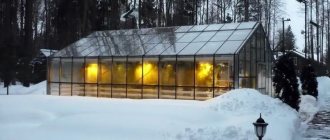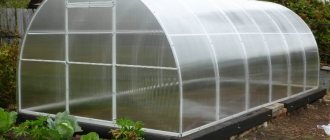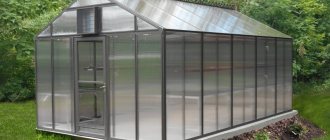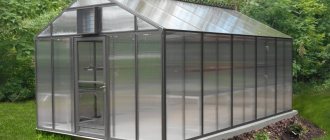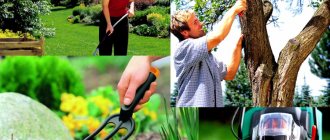Do-it-yourself greenhouse, what you need to know Everyone who personally grows vegetables on their own plot sooner or later thinks about using a greenhouse or greenhouse.
Yes, having a greenhouse at your dacha is beneficial. In it, you can not only quickly grow seedlings for subsequent transplantation into open ground, but also get a harvest of some vegetables and herbs throughout the year, regardless of weather conditions.
If you have a spacious and well-lit area, you can safely build a greenhouse. It can be used all year round without spending money on buying vegetables and herbs in the store. In small summer cottages, greenhouses can be used.
Many summer residents often have a dilemma: buy ready-made structures from a manufacturing plant or build them yourself?
It all depends on your capabilities. Of course, do-it-yourself greenhouses are the most attractive in terms of price.
But if you do not have time to manufacture the main parts, assemble and install the structure, or you are unable to do this work due to health reasons or age, then in this case there is only one option - to order from the factory.
Our website presents the best greenhouse projects for a summer residence, which you can make yourself without any problems.
Some projects require a welding machine and experience in welding, others can be made from scrap materials using a minimum of tools.
What you need to know about greenhouses
Purpose
Like a greenhouse, a greenhouse is used to create a favorable microclimate when preparing seedlings or when fully growing tomatoes, cucumbers, cabbage and other plants.
In a broad sense, both structures are perceived as the same thing, although in fact a greenhouse is a small and unheated structure. A greenhouse is a larger building with a heating and ventilation system, which allows for the cultivation of many crops at any time of the year.
Design
The structure of greenhouses is quite simple. A frame is assembled from pipes, metal or wood, which is covered with film, polycarbonate, glass, acrylic and other light-penetrating materials. If the weight of the structure is very large, it is additionally installed on the foundation.
For ventilation, removable panels or opening transoms are provided. Heating is carried out using water heating with radiators, infrared heaters or hot air from heat sources outside the greenhouse.
Installation
Since sunlight is vital for plants, the greenhouse should be built on the south side. It is advisable to place it on a slope and closer to other buildings in order to protect it from the wind and have access to utilities. It is better to stay away from high fences and trees: they provide shade, and falling leaves reduce light transmission.
Design
A greenhouse is a frame structure, it consists of the following components:
- foundation;
- frame;
- coating;
- internal equipment: heating system, lighting, etc.
For a greenhouse that is used year-round, it is necessary to have a vestibule at the northern end.
It will prevent cold outside air from entering the room with plants, and can also be used for storing equipment or installing a heater. When developing a design, it is important to ensure the possibility of high-quality ventilation.
How to make a greenhouse with your own hands from agrofibre and reinforcement
youtube.com
- Assembly complexity: low.
- Foundation: not required.
- Cost: low.
- Variations: the frame can be replaced with plastic pipes, and the covering material with film.
The simplest design option, which is ideal for a small greenhouse. A frame made of reinforcement is installed directly on the bed, and agrofibre or, as it is also called, spunbond, is stretched over it. This material protects from the sun while retaining heat and moisture.
1. The dimensions of such a greenhouse are chosen arbitrarily, depending on the footage of available materials. For example, it is convenient to cut six-meter reinforcement in half. With such a length of arcs, the width of the greenhouse is about 80 cm. The arcs themselves should be installed in increments of 1.2–1.5 m.
teplica-exp.ru
2. Arcs are bent from reinforcement with a diameter of 8 mm. Next, drip irrigation tubes or an old hose are put on them, leaving 10–20 cm at each end so that it is convenient to insert the structure into the ground.
ebayimg.com
3. After marking the installation locations for the arcs, scraps of steel pipes or drilled wooden pegs 20–30 cm long are driven into the ground, and the reinforcement is inserted into them.
stopdacha.ru
4. Spunbond can be stitched on a sewing machine, forming pocket folds that fit directly onto the arches. Another option is to install plastic pipe guides on the sides of the beds and attach agrofibre to them using purchased clips or cut pieces of pipes. The covering material can eventually be easily lifted by simply removing them.
stblizko.ru
5. If desired, you can attach the arcs not to pipes driven into the ground, but to metal guides rigidly fixed at the edges of the base. This design will allow you to fold the greenhouse like an accordion, simply by moving the arcs.
must.kz
6. The free ends of the spunbond at the ends must be collected, tied in a knot and secured with a peg, earth or other means.
samara.kinplast.ru
Here are step-by-step video instructions.
Additional recommendations
It is better to arrange a greenhouse away from trees, hills and objects that will darken the thematic structure at certain times of the day.
To ensure that the greenhouse freezes less and is well lit, it is recommended that the project be placed with the narrow side facing north.
For every 4 square meters of greenhouse area, it is necessary to arrange a window opening for ventilation with an area of 0.4x0.5 m. Moreover, the window openings must be protected with a mosquito net.
Drip irrigation is 200-300% more effective than traditional irrigation. That’s the whole answer to the question: how to make a greenhouse with your own hands if there is very little water and the plants are moisture-loving.
If the area of the greenhouse exceeds 20 sq.m., then its vertical supporting columns must be of large diameter. Moreover, these pillars must be mounted on pre-deepened piles or blocks.
How to make a greenhouse with your own hands from masonry mesh and film
dachadecor.com
- Assembly complexity: low.
- Foundation: not required.
- Cost: low.
- Variations: instead of film, you can use agrofibre, and make the door on a wooden frame.
A budget option for a greenhouse made from masonry mesh and regular film, which is quickly assembled and has a number of advantages. The design does not require a foundation; due to its elasticity, it is resistant to wind loads, and is also convenient for tying up plants from the inside. At the same time, by folding the mesh, you can get different sizes depending on your needs.
- Wooden beams, steel angles, pipes or channels are used as load-bearing posts. They are hammered at a distance of 1.2–1.4 m.
- The greenhouse arch is formed from two pieces of mesh laid overlapping. From below it is attached with wire to the posts, and from above it is fastened together with the same wire or plastic ties.
- To strengthen the structure, T-shaped supports made of wooden beams 50 × 50 mm are installed in the middle of the passage. If desired, they can also be driven into the ground.
- A film is put on a dome assembled from a mesh, which is held in place by strings of twine or rope stretched over it.
- The side walls are also made of film, which is folded up and attached to the dome with tape. In several places at the top and bottom, small windows are cut for ventilation of the greenhouse.
- The door is made on a wooden frame or made from the same film, which is cut and attached to the side wall with magnets in the manner of door mosquito nets.
Best projects
The following modifications are noteworthy:
. A gable or arched roof is divided in the middle into two parts and one of them (northern) is raised relative to the other. In the ridge area, a vertical plane is obtained where vents are installed for ventilation. To compensate for the height difference, the northern slope (or half of the arch) is made steeper. Placing the vents at the highest point ensures effective ventilation, since warm “exhaust” air rises. Overheating of plants is also prevented;
Mittleider's greenhouse- thermos greenhouse Anatoly Patiya . The building has a concrete floor, heated in the northern regions. The beds are raised, on racks or in boxes. The walls are made of polystyrene foam thermoblocks, all seams are blown in with foam or plastered. The roof has a two-layer polycarbonate sheathing; the metal rafters are painted white to prevent overheating. The inside walls are covered with foil or thermal film that reflects infrared (thermal) radiation. In a thermos greenhouse, with minimal heating and lighting costs, a microclimate is created that is comfortable even for tropical plants.
The Ivanov greenhouse is popular; the following solutions have been applied:
- the slope on the south side of the roof has a large slope so that the sun's rays fall on it perpendicularly (reflection is minimized);
- the north wall is covered with foil;
- recovery operates: warm air from under the roof is driven by the ventilation system through pipes laid in the ground, giving off its heat.
Many gardeners create their own versions, borrowing the most successful solutions from the described greenhouses.
How to make a greenhouse with your own hands from stretch film with a wooden frame
stroydachusam.ru
- Assembly difficulty: average.
- Foundation: not required.
- Cost: low.
Another way to quickly build a greenhouse. A wooden beam is used as a frame, and stretch packaging film is used as a covering material. With a large number of layers, it transmits light a little worse than ordinary PVC film, but on hot days this is even a plus.
- The film is sold in rolls, so the dimensions of the greenhouse are selected according to the cutting of the timber and taking into account your wishes.
- For the base, steel corners 40 × 40 mm are used, in which holes for attaching the frame posts are pre-drilled. They can also be treated with bitumen or painted to extend their service life.
- The corners are driven into the ground, and pieces of timber are screwed to them with self-tapping screws. A lower frame, in turn, is attached to the beam, on which the side walls and roof are assembled. All corners are reinforced with additional inclined sections of timber.
- The door is assembled on a wooden frame in one of the side walls and installed on hinges.
- Film wrapping is done in parts, in several layers and overlapping. First, the gables are installed, then the roof slopes, and only then the walls. You need to start wrapping them from the bottom so that running rainwater does not get inside the greenhouse.
- After wrapping with glazing bead or river, the door and its outer contour of the door are trimmed, and then the film around the frame is cut through. In the same way you can make a window in the opposite wall.
Coating
The frame is covered with a coating on the outside. If a polymer film is used, it is pressed from below with slats screwed to the beams of the lower frame or foundation.
All polymer materials change significantly in size with temperature fluctuations (high coefficient of thermal expansion), therefore it is recommended to lay the film at a temperature not lower than +160C - +180C. Otherwise, as the weather warms, it will sag.
For glazing, frames are attached to the frame where the glass will be installed. If possible, use old window frames, which are now being recycled in abundance due to replacement with metal-plastic windows. Polycarbonate, unlike film, cannot sag. But due to expansion, stresses arise in it that can destroy or deform the material.
To avoid deformation, leave the possibility of free movement:
- in the connecting profiles at the junction of two sheets, the latter are laid with a gap of several millimeters;
- avoid fastening the edge of the sheathing close to the frame elements;
- mounting holes are drilled with a diameter 2-3 mm larger than the self-tapping screw (the hole is sealed with a soft polymer washer).
The ends of the polycarbonate are sealed with tape, then with a plug. If the end faces down, tape and a perforated plug are used. The latter will allow condensed moisture to flow out of the honeycomb.
Having completed the installation of cellular polycarbonate, it is important to immediately remove the protective film from it.
How to make a greenhouse with your own hands from old window frames
teplica-piter.ru
- Assembly difficulty: average.
- Foundation: desirable.
- Cost: minimal.
- Variations: you can combine frames with film to make a roof, side walls or doors.
The main advantage of this design is its low cost. Old window frames can be found, if not free, then for a nominal price. In addition, glass transmits light much better than film and polycarbonate. The windows already have vents for ventilation, and if you select a balcony block, you will also have a ready-made door.
- The size of the greenhouse depends on the size of the frames and the interior space you need. Aim for a width of about 2.5 m to give a passage of about 60 cm and two beds of 80–90 cm.
- Windows and glass have considerable weight, so it is advisable to install them on a solid base. This can be a shallow strip foundation, a massive wooden beam or a metal profile.
- A wooden frame or pillars are installed on the foundation at the corners, and frames are attached to them and to each other. The gaps between each block are covered with putty and clogged with strips of laminate backing or a thin wooden strip.
- A door is made in the front wall. Its role can be played by one of the windows, a balcony door or a wooden frame covered with film. Ventilation is provided through window vents.
- To reduce weight, it is better to make the roof from wooden beams and film. You can use the same window frames, but in this case you will have to reinforce the structure with supports in the middle of the passage so that it can withstand a lot of weight.
Soil preparation
Modern greenhouses, with the exception of the thermos, have protected soil. This means that before assembling the greenhouse, the latter is lined on all sides with boards, bricks or slate sheets.
This lining allows you to visually see the area of the future structure, as well as fill its base with nutritious soil obtained from the following components:
- Turf land – 30%;
- Humus – 30%;
- Peat – 25%;
- Ash – 5%.
Before applying the appropriate mixture, you will have to loosen and remove the worn-out soil. And if the best DIY greenhouses require heating, then below the nutrient soil you can spread a bedding of sawdust and manure.
The main thing is that the plants do not reach the heating substrate with their roots. Therefore, the layer of fertilized soil should be 3-4 times larger than the lower mass.
How to make a greenhouse with your own hands from film and polypropylene pipes
maja-dacha.ru
- Assembly difficulty: average.
- Foundation: not required.
- Cost: low.
- Variations: the film can be replaced with agrofibre or polycarbonate
A greenhouse made of polypropylene pipes attracts with its simplicity, reliability and low price. The materials are sold at any hardware store, and assembly does not require any special skills or tools. You can even do without a soldering iron if you connect the pipes not with fittings, but with through bolts.
- As always, sizes are selected based on needs and available materials. Polypropylene pipe is usually sold in 4 m sections, and it is easy to cut and splice using couplings.
- The first step is to calculate the length of the pipe and the number of fittings required. It’s better to take it with a reserve so that you don’t have to run to the store later.
- The main parts are soldered from pipes, tees and crosspieces - arches with crossbars and longitudinal inserts.
- Next, the greenhouse is assembled from the prepared parts. If a soldering iron is not at hand, you can use bolts with nuts and washers to connect, which are inserted into pipes drilled through.
- The film is secured to the edges of the frame using purchased pipe clamps or homemade clips made from slightly larger diameter pipes cut along sections.
Construction sequence
The most difficult thing to build is not so much a do-it-yourself winter greenhouse from a profile pipe, but rather a low thermos gazebo. For it you have to dig a pit 1.0-1.5 meters deep. The bottom of the pit is level, and the area is equal to the area of the future greenhouse.
Next, the bottom of the recess is lined with drainage, and the walls are finished with formwork boards. A foundation is laid above the drainage and on top of the formwork to protect the interior from groundwater, cold temperatures and insects. The foundation also serves as a supporting base for the upper frame with film.
As for typical single-slope and oval gazebos, they are erected as follows:
- First, the area is cleared and the soil is processed;
- Next, vertical supporting pillars are erected;
- The next step is to fix the supporting pillars horizontally;
- Next, a farm is built on top of the pillars;
- The outside of the frame is covered with film;
- From the inside, the frame is supplemented with fittings.
In some greenhouses, the frame is assembled in such a way that the pillars do not require fixation at all. The main thing is that the site is located away from the slope. Otherwise, it may be flooded by water from precipitation.
How to make a greenhouse with your own hands from film with a wooden frame
legkovmeste.ru
- Assembly difficulty: average.
- Foundation: not required.
- Cost: low.
- Variations: the film can be replaced with agrofibre or polycarbonate.
A classic version of a greenhouse, used for decades and not losing popularity. Wooden beams are easy to process, have low weight and sufficient strength, and also retain heat well. The structure does not require a capital foundation - you can get by with a frame made of timber of a larger cross-section or use steel corners as a base.
- The standard cutting of timber is 6 m, so they start from this figure. Most often, greenhouses are made 3 × 6 m, but if desired, the dimensions can be either reduced or increased. The finished project with material calculations is available at this link.
- The assembly of the frame is the same as for a greenhouse made of stretch film. Steel corners are driven into the ground at intervals of about 1 m at the points where the posts are attached. In each of them, two holes are drilled for self-tapping screws or one for M8 or M10 bolts.
- Vertical posts are fixed to the corners along the entire perimeter, which are tied with an upper contour made of timber. To add rigidity in the corners, one jib is added on each side
- Triangular roof trusses are installed and secured opposite the racks. The slope angle is selected depending on the snow load. So, if there is a lot of snow in your region, the angle of inclination should be greater (the roof is higher and sharper).
- The door and window for ventilation are assembled on wooden frames and installed in the front and rear walls, respectively.
- At the end, the frame is covered with film, which is attached to the beam using a lath stuffed on top. All sharp parts on the wood are rounded off or covered with a soft material so that the film does not tear during operation.
Materials for production
The key component of the greenhouse is a transparent, windproof covering. There are several materials suitable for its manufacture. The advantages and disadvantages of each of them are discussed in detail below.
Film
Polymer film is the cheapest option, but it has significant disadvantages:
- low strength;
- low thermal resistance;
- short service life. The material must be replaced after 1-2 seasons.
Low strength and thermal resistance make the film unsuitable for constructing winter greenhouses.
Several types of polymer films are used:
- polyethylene or polypropylene . It is recommended to use the reinforced version - it is stronger;
- special nonwoven materials based on polymer fibers . This is a fairly large group: lutrasil, agrospan, agrotex, etc. Different polymers are used for their manufacture. For example, lutrasil is made from polypropylene. These materials are much stronger than ordinary polyethylene film.
An important advantage of some polymer films is their repairability: the break point can be soldered, thus restoring the integrity of the coating.
Glass
An important advantage of glass is almost absolute transparency. By using double glazing, the thermal resistance of the coating is increased, but its transparency remains the same. This makes it possible to build winter greenhouses from glass.
But there are also important disadvantages:
- considerable weight . Requires a powerful frame;
- fragility . Upon impact, it cracks with the formation of traumatic fragments;
- high thermal conductivity . Glass is a cold material and even with double glazing, heat loss is relatively high.
These shortcomings prompted scientists to create an alternative - organic glass, that is, transparent plastic. Of all the types, polycarbonate has become the most popular.
Polycarbonate
When constructing greenhouses, the so-called cellular polycarbonate is predominantly used - panels of two sheets of plastic separated by stiffening ribs. Plastic has low thermal conductivity; in addition, there is an air gap between the ribs, so cellular polycarbonate saves heat much more effectively than glass.
They produce panels with different thicknesses: 4, 6, 8, 10, 16 mm and upon individual order - 20 and 32 mm. A thick panel is stronger, but its light transmittance is lower.
So, for a 10 mm thick panel it is 72%, and for a 16 mm thick panel it is 62%. Sheets with a thickness of 10 mm are considered optimal for the roof of a winter greenhouse, and 6 or 8 mm for a summer greenhouse . In the summer version, the walls can be sheathed with “four”; for the winter version, warmer “six” or “eight” will be required.
For outdoor use, sheets with UV protection are required, otherwise the plastic will degrade within a year. There are panels with protection on both sides - it is not advisable to purchase them for greenhouses. Another advantage of polycarbonate is its flexibility, which allows you to create curved (arched) structures. It is important to consider the minimum bend radius - it depends on the thickness of the sheet.
How to make a polycarbonate greenhouse with a metal frame with your own hands
- Assembly difficulty: high.
- Foundation: required.
- Cost: high.
- Variations: the foundation can be made of wooden beams or use steel reinforcement, angle or pipes driven into the ground.
The most popular and modern version of the greenhouse. This design is much more expensive than others and is difficult to manufacture, but it will last for decades. Polycarbonate can withstand the open sun for 10–12 years, and the frame made of a profile steel pipe is almost eternal.
1. The standard size of polycarbonate is 2,100 × 6,000 mm, so it is convenient to cut it into four or two parts with dimensions of 2.1 × 1.5 m or 2.1 × 3 m, respectively. Such pieces will be optimal for a greenhouse measuring 3 × 6 meters.
2. For reliable fastening and distribution of wind loads, a foundation is made under the greenhouse. This can be a shallow strip foundation, a frame made of antiseptic-treated wooden beams, or steel corners driven into the ground.
YouTube channel of Evgeniy Kolomakin
3. The design of the greenhouse consists of an arch, which is formed using arcs from a profiled steel pipe 20 × 20 mm, located at a distance of one meter from each other.
4. The arcs are fastened together by longitudinal sections from the same pipe, which are connected by welding.
5. A door is installed at the front end: a frame measuring 1.85 × 1 m is welded from a pipe, which is attached to the frame on hinges. A window for ventilation measuring 1 × 1 m is made according to the same principle and is located at the rear end.
6. Covering with polycarbonate begins from the ends. The sheet is cut in half, attached to the profile using special self-tapping screws with thermal washers, and then trimmed along the contour of the arc with a sharp knife. After this, the side wall sheets are installed.
Solutions for problem areas
The site is located in an area with high humidity and has uneven terrain. How to install a greenhouse on it?
- Before starting construction, you should find a place and select a segment on it that should be located higher and more even. This is where the passage will be located.
- After installation, it is dug in with ditches along the outer perimeter. The top layer of turf can be used to fill the beds.
The main distinguishing feature of the installation in such areas is the bulk ridges. They differ in that in the first year of a good harvest it is not worth reaping. But the longer the greenhouse is in use, the better the quality and quantity of the harvest.
How to make a polycarbonate greenhouse with a galvanized profile frame with your own hands
techkomplect.ru
- Assembly difficulty: average.
- Foundation: not required.
- Cost: low.
A simpler and more affordable option for a polycarbonate greenhouse. It does not use expensive metal pipe that needs to be welded. And galvanized profiles for plasterboard systems are used as frame material. They are easily cut with metal scissors and fastened with ordinary self-tapping screws.
- When choosing sizes, as usual, we start from the parameters of polycarbonate sheets. Since the profiles lose rigidity when bent, it is better to choose a gable greenhouse rather than an arched one.
- By analogy with arches made of a metal pipe, a frame made of galvanized profile is assembled from ribs in the form of a house.
- The assembled modules are installed on a frame made of wooden beams and tied together with sections of profiles. Doors and a window for ventilation are made in the front and rear walls.
- At the end, the frame is sheathed with polycarbonate sheets, which are secured using special self-tapping screws with plastic thermal washers.
Wall mounted
Such greenhouses are good because they can be used in winter without major financial investments, since it is not at all difficult to organize the flow of heat into the greenhouse directly from home.
Please pay attention to one important point - wall structures must be installed on the south side (this is important!).
Greenhouse fence
Can act as a stand-alone fence or in combination with an existing fence.
This option attracts many summer residents because it allows not only to save space on the site. You can also save on materials, which, of course, is good news.
Thermos
One of the most successful options for use in winter. This design allows you to grow vegetables even in severe frosts.
Underground
Such structures are buried 1.5-2 meters into the ground. The coating most often used is polycarbonate.
When using such a greenhouse in winter, there is usually no need to install heating equipment. But the costs of its construction are still considerable.
How to make a glass greenhouse with a metal frame with your own hands
juliana.ru
- Assembly difficulty: high.
- Foundation: required.
- Cost: high.
- Variations: to make the structure lighter, you can make the top from polycarbonate or film.
The most correct, but rather labor-intensive and expensive option for a greenhouse. The main advantage of glass is its excellent light transmittance and durability. However, due to the heavy weight of the structure, a strong metal frame and foundation are required. In addition to arranging a strip foundation, the difficulty also lies in the need to use welding.
- When it comes to choosing sizes, a glass greenhouse is no exception - everything is strictly individual and taking into account the available materials.
- The impressive weight of glass and metal frame requires a full foundation. Usually a trench 30 cm deep and 20 cm wide is dug around the perimeter, wooden formwork 20 cm high is installed on top and the whole thing is filled with concrete. Also, before pouring, anchor bolts are inserted into the formwork to secure the frame.
- A metal channel or corner is attached to the resulting base using anchors. Then racks 1.6–1.8 m high are welded to this frame from two folded corners 45 × 45 mm. At the top they are fastened with longitudinal sections of the corner.
- Next, rafters from the same double corners are placed on the resulting box. At the bottom they are welded to the posts, and at the top - to another corner, which acts as a ridge beam.
- A door is inserted into one of the walls, and a window is installed in the lid or wall for ventilation.
- The glass is installed in the frames obtained by using double corners and secured with homemade gluers - thin aluminum or steel plates bent in the shape of the letter Z. The gluer is attached to the corner with one hook, and to the glass with the second.
Ventilation
There are two types of ventilation used in greenhouses:
- natural _ Ventilation is carried out periodically by opening doors and vents. The latter are placed as high as possible - the exhaust warm air rushes upward. Some plants, for example, bell peppers, do not tolerate drafts, so it is necessary to provide a sufficient number of vents on one side;
- forced _ The supply of fresh air and removal of exhaust air is carried out through an air duct system due to the action of a fan.
Artificial ventilation will be more expensive, but it has advantages:
- fresh air enters evenly and in a controlled manner, which allows you to create the most comfortable microclimate;
- It is possible to use a recuperator - a device that takes heat from the exhaust air and transfers it to the injected fresh air. This system significantly reduces heating costs.
Natural ventilation
In amateur greenhouses, natural ventilation is more often used; it is also divided into two types:
- manual. The windows open and close manually;
- automatic _ In expensive systems, the controller opens the vents based on a signal from the temperature sensor. Cheap ones use non-volatile analog automation in the form of a bimetallic plate or capsule with a liquid that has a high coefficient of thermal expansion.
How to make a dome greenhouse with your own hands from film with a wooden frame
pinterest.com
- Assembly difficulty: high.
- Foundation: desirable.
- Cost: high.
- Variations: the film can be replaced with polycarbonate or glass, and the frame can be made of profiles or pipes.
A domed or geodesic greenhouse attracts primarily with its unusual appearance: it consists entirely of many triangles and hexagons. Other advantages include high structural strength and best light transmittance. The geodesic dome has only one drawback: it is difficult to manufacture.
- The dimensions of such a greenhouse are selected individually, based on the required area. Since the frame design is quite complex, calculations are the most time-consuming part of the project.
- In order not to get confused and take into account all the nuances, it is convenient to carry out the calculation using a special calculator. In it you can set the dimensions, select the “thickness” of the frame and get a list of all the necessary parts for assembly with dimensions, as well as their approximate cost.
- Regardless of its dimensions, a domed greenhouse is highly durable and is not afraid of winds, so there is no need to make a foundation for it. However, since the construction of a structure is very labor-intensive, it is rational to extend its service life and equip a lightweight strip foundation for attaching the frame.
- The ribs of the structure consist of triangles, which, in turn, are assembled from a wooden batten according to a template. First you need to prepare the required number of such triangles.
- The greenhouse is assembled like a magnetic construction set from childhood. Starting from the bottom, rows of triangles are assembled one after another, which are fastened together using self-tapping screws and form a dome. If everything is calculated correctly, it will close at the top and will be perfectly shaped.
- One of the triangles in the roof is made folding or removable to provide ventilation. The door is either installed in a polygon shape, or made in a traditional shape with a mortise frame.
- The film covers the finished dome or is stretched over each triangle at the assembly stage. In the first case, it will be easier to replace the film when it breaks. The second one gives a more aesthetic appearance. Which one to choose - decide for yourself.
Foundation
The top layer of soil becomes limp during the rainy season and when the snow melts, so the greenhouse is installed on more stable deep layers. This requires a foundation. At the same time, the latter does not have to be lowered below the depth of soil freezing: the forces of frost heaving will not harm a light frame building.
Thus, the greenhouse is built on a shallow foundation, about 40-50 cm deep. Like any frame structure, a columnar foundation is suitable for a greenhouse.
The pillars are laid out from the following materials:
- Red brick;
- rubble (unprocessed stone fragments);
- concrete: poured into a hole previously drilled with a garden drill, lined from the inside with roofing felt.
But the columnar foundation has a drawback: it does not separate the outer soil from the inner one and does not protect the latter from freezing and penetration of weeds. Such phenomena are dealt with by an insulated strip foundation, laid out from piece building materials or cast from concrete.
A budget option is a foundation made of wooden beams with a cross-section of 15x15 cm. In order to extend their service life in the ground, they are treated with an antiseptic, fired and wrapped in roofing felt or coated with tar.
Under the foundation, regardless of its type, a sand and gravel cushion 10-15 cm thick is laid. This is a material with high drainage properties, thanks to which the base of the foundation remains dry.
